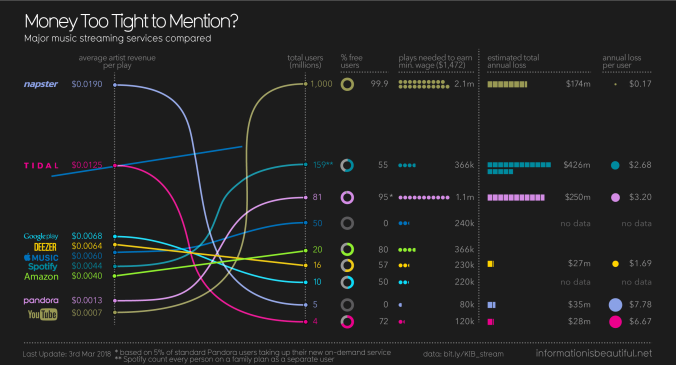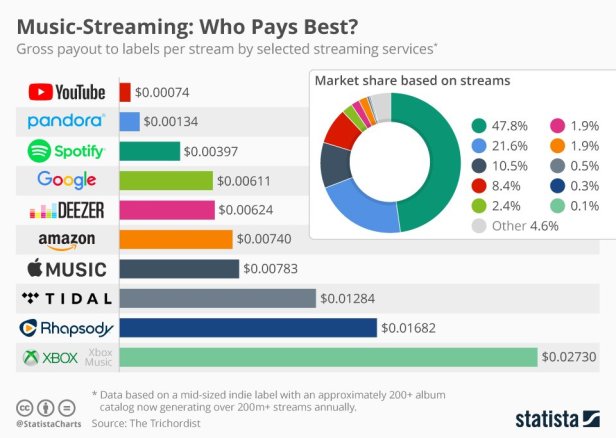Streaming is all the rage. But–it is cannibalizing higher margin goods, even digital goods. Because of the industry standard revenue share method of dividing up royalties, all artists essentially get a market share allocation of streaming service revenue based on the number of streams. Plus, with some exceptions, your royalty rate is dependent on factors you have no control over. What this means in simple math is that streaming royalties on a per-stream basis will always decline over time (see also Mathusianism).

From Information is Beautiful https://informationisbeautiful.net/visualizations/spotify-apple-music-tidal-music-streaming-services-royalty-rates-compared/
Artists’ dismal streaming royalties on music subscription services are largely based on a simple calculation: A per-stream payment derived from a share of the service’s revenue prorated by number of streams. Artists get a portion of a service’s monthly revenue (at least the revenue the service discloses) based on a ratio of your plays to all the plays. Your plays will always be a lot smaller than the total plays. (This is essentially what Sharky Laguana referred to as the “Big Pool.”)r
Sounds simple, but mixed with the near-payola of Spotify’s playlist culture and Pandora’s “steering” deals, it’s really not. Negotiating leverage allows big stakeholders to tweak the basic calculation with royalty floors, advances (aka breakage), nonrecoupable payments that help cover accounting costs, and other twists and turns to avoid a pure revenue share. All of which approximate a per-stream rate on a Rube Goldberg level, by the way, which is one thing these services seem to resist.

Cartoonist Rube Goldberg’s Automatic Back Scratcher
It’s pretty safe to say that all new artists get hosed on streaming royalties. Setting aside the fact that your distributor will never get all the goodies that the big labels get in their deals, this is because even if a fan listens to your tracks only for a month, well over 90% of that fan’s subscription payment is allocated to artists she didn’t listen to and may not even like. Of course all these machinations happen behind the scenes. Fans are not usually not aware that their subscription pays for music they don’t listen to and artists they never heard of or don’t care for. Plus, it’s virtually impossible for any label, digital distributor or publisher to tell an artist or songwriter what their per-stream rate is or is going to be.
Revenue share deals for big stakeholders have some bells and whistles that leverage can get you, like per-subscriber minimums, conversion goals, top up fees, limits on free trials, cutbacks on “off the top” revenue reductions, and the percentage of revenue in the pool (50%—60%-ish). Even so, the basic royalty calculation in a revenue share model is essentially this equation calculated on a monthly basis:
(Net Revenue * [Your Streams/All Streams])
Or ([Net Revenue/All Streams] * Your Streams)
In other words all the money is shared by all the artists.
Sounds fair, right?
Wrong. First, all artists may be equal, but on streaming services, some are more equal than others. Regardless of the downside protection like per-subscriber or per-stream minima, the revenue share model has an inherent bias for the most popular getting the most money out of the “Big Pool.” (This is true without taking into account the unmatched.)
And of course it must be said that the more of those artists are signed to any one label, the bigger that label’s take is of the Big Pool. So the bigger the label, the more they like streaming.
Conversely, the smaller the label the lower the take. This is destructive for small labels or independent artists. That’s why you see some artists complaining bitterly about a royalty rate that doesn’t have a positive integer until you get three or four decimal places to the right. Why drive fans away from higher margin CDs, vinyl or permanent downloads to a revenue share disaster on streaming? Because it’s all the rage.
Yet it increasingly seems that we are all stuck with the nonsensical streaming revenue share model with ever-declining per-stream rates. Why is the rate guaranteed to decline?
If the month-over-month rate of change in revenue (the numerator) is less than the month-over-month rate of change in the total number of streams or sound recordings streamed on the service (the denominator), the per-stream rate will decline over those months. This is because there will be more recordings in later months sharing a pot of money that hasn’t increased as rapidly as the number of streams.
As the number of recordings released will always increase over time for a service like Spotify that licenses the total output of all major and indie labels (and independent artists), it is likely that the total number of recordings streamed will increase at a rate that exceeds the rate of change of the net revenue to be allocated. If there are more recordings, it is also likely that there will be more streams.
So streaming royalties in the Big Pool model will likely (and I would say necessarily will) decline over time. That’s demonstrated by declining royalties documented in The Trichordist’s “Streaming Price Bible” among other evidence.

There is a move afoot to switch to a “user centric” model of revenue share allocation that rewards the artist with a share of everyone who listens to them. I have a version of that concept I call the Ethical Pool. But the simplest approach would be to abandon the revenue share model altogether and negotiate a per-stream royalty–unfortunately, no one seems to be interested in the simplest approach.
For our purposes, just understand that regardless of what you hear about streaming saving the industry, streaming is unlikely to save you.
[from http://bit.ly/2llz3cO]

No comments:
Post a Comment